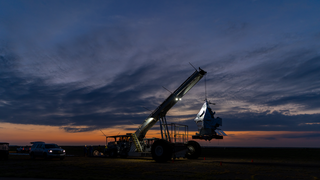Fort Sumner, New Mexico: 2024 Drone Views
This clip contains various shots of the NASA payload processing facility at Fort Sumner as well as general views of the surrounding area, acquired Aug. 23, 2024.
Credit: NASA/Francis Reddy
Video playback is at half speed (30 fps). 0:00 A slow, early morning approach to the staging facility as its doors open, revealing the EXCITE (EXoplanet Climate Infrared TElescope) payload. 0:45 The camera descends, with the rising sun moving behind the staging facility. 0:58 A closer, lower approach to the EXCITE payload. 1:10 A higher, more distant arc that starts by showing the low sun and the NASA sign on the staging facility, moving north. 1:41 A slow ascent looking toward EXCITE and the morning sun. 1:28 Hovering as the doors close on EXCITE. 03:20 Overview flying back across the airport revealing various vehicles and structures. 4:41 Similar, but at higher altitude and flying in a different direction.
Columbia Scientific Balloon Facility (CSBF) Fort Sumner is located at the Fort Sumner Municipal Airport, New Mexico. CSBF Fort Sumner consists of a large World War II hangar — used for equipment, launch vehicle storage, and science payload storage and integration — a NASA Flight/Staging Facility that includes offices and an operations control center, and a launch pad. The site, partially owned by Fort Sumner Village, is a former Army Air Corps Base that eventually became the Fort Sumner Municipal Airport. The village of Fort Sumner lies to the southwest, with lands immediately surrounding the CSBF facility being privately owned and generally vacant. More information is available here.
This clip contains various shots associated with the Aug. 28, 2024, launch of the HASP (High Altitude Student Platform) 2.0 payload, an engineering test flight of an upgraded gondola and systems, aiming to double the number of student payloads compared to the current HASP program. HASP is currently designed to carry up to 12 student payloads to an altitude of about 22 miles (36 kilometers) with flight durations of 15 to 20 hours using a small volume, zero pressure balloon. Learn more about HASP here.
Credit: NASA/Francis Reddy
Video playback is at half speed (30 fps). 0:00 Early morning ascent looking down the flight line, revealing two trucks carrying helium, a partially inflated balloon, various personnel and vehicles, and, visible at top in the highest shot, the vehicle carrying the payload. 1:07 A flight near the ground sliding right along the flight line, and then in the opposite direction.

View of the flight line at Fort Sumner on the morning of Aug. 28, 2024, during preparations to launch the HASP 2.0 mission, looking northwest.
Credit: NASA/Francis Reddy
Image description: In the middle distance, personnel in yellow safety vests and a variety of vehicles are scattered horizontally across the frame. At left, a white tractor trailer carrying long, white cylinders rests next to a partially inflated balloon attended by the flight crew. The remainder of the balloon stretches across the frame, along the ground to the right, and is attached to a conical white-and-orange parachute whose shroud lines continue right toward an odd-looking vehicle. The lines gather at the end of an extendable arm held above the vehicle, which has very large rear tires, and drape downward as they support the balloon payload. The foreground is reddish gray dirt flecked with short vegetation that changes to old gray asphalt where short plants have broken through, creating irregular channels in various shades of green. In the background, an old aircraft hangar appears at left along with other buildings, the sky near the horizon is a hazy gray, while higher up it's a nearly cloudless slate blue.
Drone imagery showing the launch of HASP 2.0 from Fort Sumner on Aug. 28, 2024.
Credit: NASA/Francis Reddy
Video playback is at half speed (30 fps). At 0:11, the inflated balloon rises vertically, gradually reaching its full height by 1:49. The camera turns to keep it centered in the frame as the launch vehicle holding the payload maneuvers. 2:14 The launch collar, a device that holds the balloon film together following its initial release, slowly tumbles to earth. 2:38 The payload is launched, the balloon climbs into a blue sky peppered with a few clouds, and the camera rises, tilts, and rotates to follow it.
For More Information
See NASA.gov
Credits
Please give credit for this item to:
NASA's Goddard Space Flight Center. However, individual items should be credited as indicated above.
-
Producer
- Sophia Roberts (Advocates in Manpower Management, Inc.)
-
Drone pilot
- Francis Reddy (University of Maryland College Park)
-
Writer
- Francis Reddy (University of Maryland College Park)
-
Drone crew
- Jeanette Kazmierczak (University of Maryland College Park)
- Cecelia Vitale-Reddy (Prince George's Community College)
Release date
This page was originally published on Monday, January 22, 2024.
This page was last updated on Tuesday, January 21, 2025 at 5:51 PM EST.
